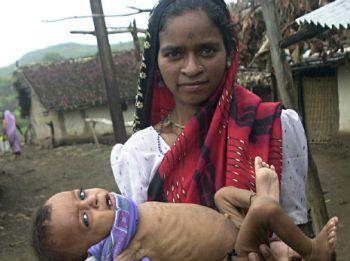Melghat: a synonym for malnutrition
Malnutrition is a byword in the forested hills of the Melghat region inhabited mostly by Korku Adivasis. Every year 400-500 children between the ages of 0 and 6 die in the region, comprising Chikhaldhara and Dharni taluks, according to official figures from 2005.
The Problem: Thousands of kids die every year in the tribal area of Melghat (Maharashtra, India) due to lack of medical attention and nutritional support. Increased incidence and rapid spread of infectious diseases such as pneumonia, typhoid, and dysentery are primary cause of high child mortality. Situation worsens during monsoon when the food supplies are low and the communicable diseases are at their peak.
Melghat is also a place known for high infant mortality rate. Some reasons for the health crisis in Melghat include lack of infrastructure, under-equipped and under-staffed public health and ICDS centres, the tradition of early marriages and early motherhood, lack of sanitation and clean drinking water facilities and the tribals’ blind faith in bhumkas (quacks).
Failed Operations of the past: When the Maharashtra government first recorded the figures of child deaths due to endemic malnutrition in the remote villages of Melghat, shocking numbers were revealed.Almost two decades later, even though the government figures show a substantial drop in the number of malnutrition deaths, social activists and health-coordinators working in the impoverished area say that the authorities pass off such deaths as still-births.
The reality continues to bite with the data recorded just before monsoon this year, indicating 509 malnutrition induced deaths during past year, until March 2011. Every year, hundreds of children of Korku tribe in the tehsils of Melghat in the Satpura ranges fall prey to starvation and malnutrition. While the government records indicate figures ranging from 400-525 in the last five years, health activists working among the tribals tell a different story.
Madhukar Mane, Health Coordinator with NGO Maitri, which organises monsoon campaigns to prevent deaths in the precarious season, says: “The figures are certainly better than the late 90s but the numbers are still very high in the tehsils of Dharni and Chikhaldhara. Government records child deaths under two categories: still birth and neonatal. What happens is that they write off several deaths as still births so that the infant mortality rate (IMR) could be kept under check.
Ray of Hope: mhealth is now bringing about a change in India. My two adopted ones- Bongu and Priti along with several others are now fighting malnutrition in their region..I adopted these two angels with the help of World vision India.
The community health workers in Melghat are given the latest weapon to fight against the silent killer – malnutrition. It’s a mobile phone pre-loaded with an application called CommCare. “Whenever a pregnancy is reported, I register the women’s name and other details via the phone,” a community health worker explains.
Once the registration is done, the software gives her the woman’s expected delivery, check-up and immunisation dates. The phone also has pre-recorded messages on maternal and child health that can be played for the women.
Once data is collected, it is saved on a central server of World Vision India, a non-profit organisation that works closely with the government, which distributed these phones. The information then helps in monitoring the health of pregnant women, lactating mothers and young children. The government is now toying with the idea of expanding this successful service to other districts of the state.
Recommendations: Government need to provide access to basic healthcare using mHealth/Telemedicine. About 50 per cent families in Melghat are below poverty line with a high rate of unemployment. Weak mothers often deliver children in grade 1 malnutrition.
It almost instantly deteriorates to grade 2, and then 3 & 4. The nearest emergency health care is about 120 km away that too without a child specialist or medical equipment. About 39 children are suffering from grade 4 malnutrition while 442 fall under grade 3 here.
Here are some of the basic needs of the people in Melghat:
- Proper Scientific Nutrition, including Micronutrients.
- Preventive Health
- Mother and Child Care
- Reactivating Comprehensive Education system
- Transportation & Roads
- Availability of permanent Employment Guarantee during the non-agricultural season.
The health of Melghat cannot change overnight. But tough monitoring and creative solutions along with the State-led ones, the primary being the crucial Right to Food law, can hopefully nurse it back to good health in future.
Comments welcome!
References
Dr A. Ghosh- Team BHP
Commcare
http://www.hindustantimes.com/News-Feed/Columns/Spoon-feeding-Melghat/Article1-953028.aspx
http://indiatoday.intoday.in/story/government-fudges-mortality-records-in-melghat/1/153486.html
http://supriyassule.com/en/projects-and-developments/melghat
To read other posts in this exclusive ongoing series, please visit the Mobile Health Around the Globe main page. And if you have a Mobile Health Around the Globe story to tell, please post a comment below or email me at joan@socialmediatoday.com Thanks!
